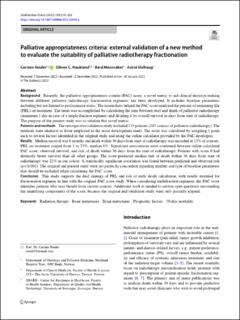| dc.contributor.author | Nieder, Carsten | |
| dc.contributor.author | Haukland, Ellinor Christin | |
| dc.contributor.author | Mannsåker, Bård | |
| dc.contributor.author | Dalhaug, Astrid | |
| dc.date.accessioned | 2023-06-27T11:10:40Z | |
| dc.date.available | 2023-06-27T11:10:40Z | |
| dc.date.created | 2023-03-29T11:22:46Z | |
| dc.date.issued | 2023 | |
| dc.identifier.citation | Nieder, C., Haukland, E. C., Mannsåker, B., & Dalhaug, A. (2023). Palliative appropriateness criteria: external validation of a new method to evaluate the suitability of palliative radiotherapy fractionation. Strahlentherapie und Onkologie, 199 (3), 278-283. | en_US |
| dc.identifier.issn | 0179-7158 | |
| dc.identifier.uri | https://hdl.handle.net/11250/3073456 | |
| dc.description.abstract | Background
Recently, the palliative appropriateness criteria (PAC) score, a novel metric to aid clinical decision-making between different palliative radiotherapy fractionation regimens, has been developed. It includes baseline parameters including but not limited to performance status. The researchers behind the PAC score analyzed the percent of remaining life (PRL) on treatment. The latter was accomplished by calculating the time between start and finish of palliative radiotherapy (minimum 1 day in case of a single-fraction regimen) and dividing it by overall survival in days from start of radiotherapy. The purpose of the present study was to validate this novel metric.
Patients and methods
The retrospective validation study included 219 patients (287 courses of palliative radiotherapy). The methods were identical to those employed in the score development study. The score was calculated by assigning 1 point each to several factors identified in the original study and using the online calculator provided by the PAC developers.
Results
Median survival was 6 months and death within 30 days from start of radiotherapy was recorded in 13% of courses. PRL on treatment ranged from 1 to 23%, median 8%. Significant associations were confirmed between online-calculated PAC score, observed survival, and risk of death within 30 days from the start of radiotherapy. Patients with score 0 had distinctly better survival than all other groups. The score-predicted median risk of death within 30 days from start of radiotherapy was 22% in our cohort. A statistically significant correlation was found between predicted and observed risk (p < 0.001). The original and present study were not perfectly concordant regarding number and type of baseline parameters that should be included when calculating the PAC score.
Conclusion
This study supports the dual strategy of PRL and risk of early death calculation, with results stratified for fractionation regimen, in line with the original PAC score study. When considering multifraction regimens, the PAC score identifies patients who may benefit from shorter courses. Additional work is needed to answer open questions surrounding the underlying components of the score, because the original and validation study were only partially aligned.
Introduction | en_US |
| dc.language.iso | eng | en_US |
| dc.publisher | Springer | en_US |
| dc.rights | Navngivelse 4.0 Internasjonal | * |
| dc.rights.uri | http://creativecommons.org/licenses/by/4.0/deed.no | * |
| dc.title | Palliative appropriateness criteria: external validation of a new method to evaluate the suitability of palliative radiotherapy fractionation | en_US |
| dc.type | Peer reviewed | en_US |
| dc.type | Journal article | en_US |
| dc.description.version | publishedVersion | en_US |
| dc.rights.holder | The authors | en_US |
| dc.subject.nsi | VDP::Medisinske Fag: 700 | en_US |
| dc.source.pagenumber | 278-283 | en_US |
| dc.source.volume | 199 | en_US |
| dc.source.journal | Strahlentherapie und Onkologie (Print) | en_US |
| dc.source.issue | 3 | en_US |
| dc.identifier.doi | 10.1007/s00066-022-02040-y | |
| dc.identifier.cristin | 2138022 | |
| cristin.ispublished | true | |
| cristin.fulltext | original | |
| cristin.qualitycode | 1 | |

